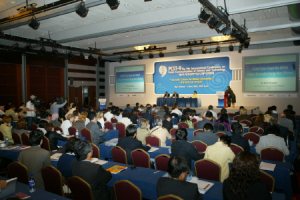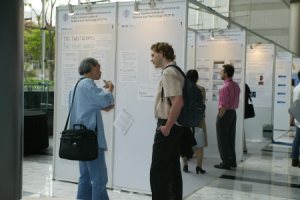|
つくば生物ジャーナル Tsukuba Journal of Biology (2006) 5: TJB200608JM.
Kim Chee and talking scienceJennifer Manyweathers(筑波大学 生命環境科学研究科)
Kim Chee and talking scienceQ: What do you get when you mix kim chee, and people who love talking about science? A: A science communication conference in Korea. May 2006 saw the 9th International Conference on Public Communication of Science and Technology (PSCT-9). It was the first time a PCST gathering was held in Asia and the timing was exquisite. Science communication is being discussed and explored all over Asia. This was particularly well illustrated by the Japanese attendance at the conference. They were second in number only to the Korean participants. Representatives from Hokkaido University, the University of Tokyo, and Kyoto University presented papers and posters. The Japanese Science and technology Agency (JST), The National Science Museum and Miraikan were also represented. The Korean conference had a theme of Scientific Culture for Global Citizenship. Some of the papers presented are listed below. ● When education prevents the uptake of science: The case of childhood immunisation in Australia. ● To connect to citizens, researchers must rethink their research practices. ● Genome research and communication with the public in Japan. Science Communication has recently become a very popular concept. Some scientists are left wondering what it was that they were doing before “science communication” came along. What does science communication actually involve? Why do we need a conference to talk about it? Science communication is sharing knowledge. This can be between scientists who are colleagues, or with scientists from other disciplines. It also involves sharing scientific knowledge with those who may not have a scientific background. The former sounds a lot like what most scientists do everyday. Scientists generally do not need assistance in learning how to communicate with other scientists, although some do better than others. The main component of science communication is for scientists to encourage public interest in and engagement with science. This raises all sorts of questions. Is it the role of the scientists? Why? What is public engagement? Why is it important? How do we know when it is achieved? These are all questions that PCST attempts to deal with. PCST is a collection of people who have an interest in science communication. They may be scientists, journalists, people working in science centres and museums, academics, theatre directors. They are united by their interest in how science is discussed and presented. PCST’s main arena for discussion is via the Internet. Face-to-face meetings take place whenever possible. Every two years there is an international conference with a different theme. Anyone can join PCST. You then have access to a forum to discuss science communication ideas and issues. You can find more PCST details on www.pcstnetwork.org/. There are many challenges facing scientists including research funding, maintaining a high level of research in the laboratory, and finding and keeping research students happy. There seems very little time leftover for communication. But of course, the better we communicate about our science, the more likely it is that those challenges will become easier.
Contributed by Jennifer Manyweathers, Received July 26, 2006.
©2006 筑波大学生物学類
|



